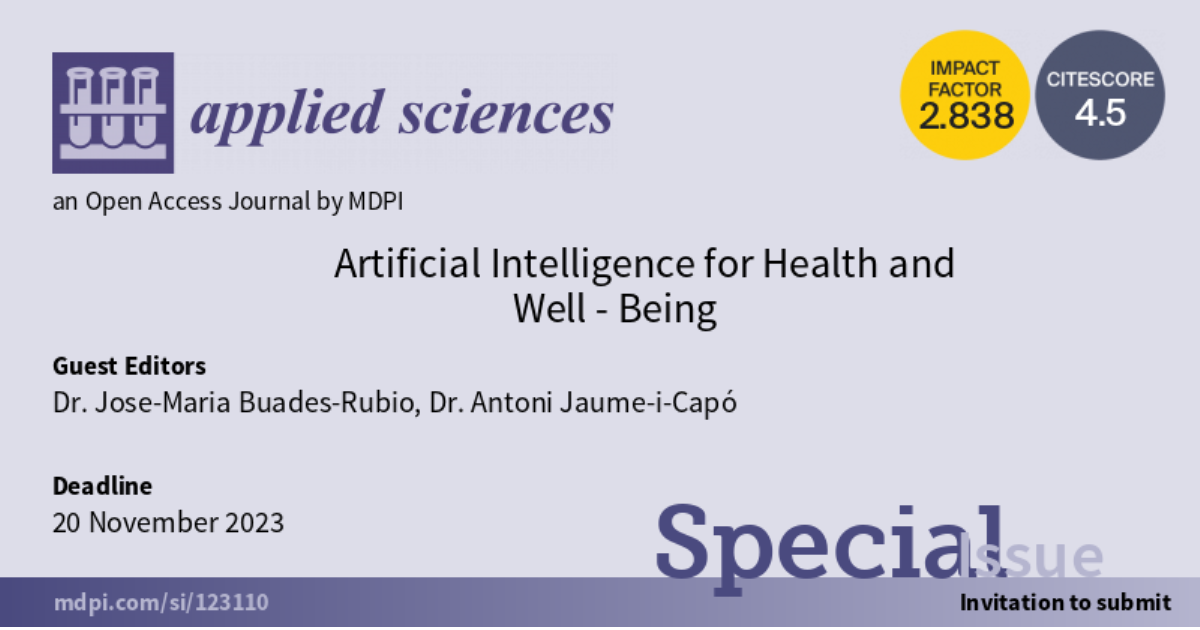Artificial Intelligence for Health and Well-Being
A special issue of Applied Sciences (ISSN 2076-3417). This special issue belongs to the section "Computing and Artificial Intelligence".
Deadline for manuscript submissions: closed (20 November 2023) | Viewed by 27574

Special Issue Editors
Interests: computer graphics; computer vision; artificial intelligence
Interests: computer vision; vision-based interfaces; interactive systems for motor rehabilitation; medical image processing; human-based computing for image processing
Special Issue Information
Dear Colleagues,
Artificial intelligence is poised to change the world in the coming decades, from the way we do business to domestic applications. Artificial intelligence gives systems the ability to learn and make decisions, benefiting areas such as medicine and well-being.
This Special Issue aims to disseminate the latest research results and developments in artificial intelligence for health and well-being. We at inviting researchers and practitioners to contribute their high-quality original research or review articles on these topics to this Special Issue.
Topics of interest include, but are not limited to:
- Machine learning in health and well-being;
- Data analysis in health and well-being;
- Social robots;
- Affective computing;
- Medical image processing;
- Intelligent medical devices and sensors;
- Medical expert systems;
- Explaining AI in medical systems;
- Computer-aided diagnosis.
Dr. Jose-Maria Buades-Rubio
Dr. Antoni Jaume-i-Capó
Guest Editors
Manuscript Submission Information
Manuscripts should be submitted online at www.mdpi.com by registering and logging in to this website. Once you are registered, click here to go to the submission form. Manuscripts can be submitted until the deadline. All submissions that pass pre-check are peer-reviewed. Accepted papers will be published continuously in the journal (as soon as accepted) and will be listed together on the special issue website. Research articles, review articles as well as short communications are invited. For planned papers, a title and short abstract (about 100 words) can be sent to the Editorial Office for announcement on this website.
Submitted manuscripts should not have been published previously, nor be under consideration for publication elsewhere (except conference proceedings papers). All manuscripts are thoroughly refereed through a single-blind peer-review process. A guide for authors and other relevant information for submission of manuscripts is available on the Instructions for Authors page. Applied Sciences is an international peer-reviewed open access semimonthly journal published by MDPI.
Please visit the Instructions for Authors page before submitting a manuscript. The Article Processing Charge (APC) for publication in this open access journal is 2400 CHF (Swiss Francs). Submitted papers should be well formatted and use good English. Authors may use MDPI's English editing service prior to publication or during author revisions.
Keywords
- artificial intelligence
- machine learning
- healthcare and well-being informatics
- explainable systems
- deep learning
- bioinformatics
- AI in medicine
Benefits of Publishing in a Special Issue
- Ease of navigation: Grouping papers by topic helps scholars navigate broad scope journals more efficiently.
- Greater discoverability: Special Issues support the reach and impact of scientific research. Articles in Special Issues are more discoverable and cited more frequently.
- Expansion of research network: Special Issues facilitate connections among authors, fostering scientific collaborations.
- External promotion: Articles in Special Issues are often promoted through the journal's social media, increasing their visibility.
- e-Book format: Special Issues with more than 10 articles can be published as dedicated e-books, ensuring wide and rapid dissemination.
Further information on MDPI's Special Issue policies can be found here.





